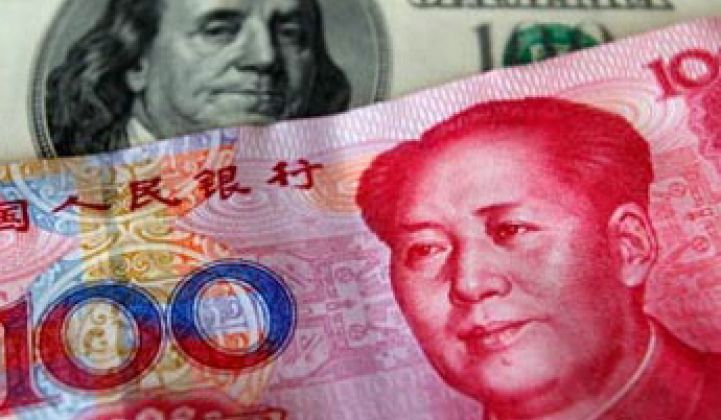About a week ago, the Solar Energy Industries Association (SEIA) published its proposal on how to end the solar trade war between the U.S. and China by eliminating tariffs on solar cells and establishing a fund to even the playing field for U.S. manufacturers. To say that the peace plan made a big splash would be more than a slight exaggeration.
While SEIA warned that the “recent trade conflict within the industry threatens to permanently damage both the U.S. and Chinese solar industries, with casualties growing by the day,” only the usual suspects offered foreseeable concerns. Most of all, Gordon Brinser, U.S. president of manufacturing for SolarWorld and leader of the Coalition for American Solar Manufacturing (CASM), remained “highly skeptical of any settlement with China or Chinese companies given their history of predatory market and trade practices.”
So it doesn't sound like he is ready to hold out an olive branch just yet. But SEIA's John Smirnow, vice president for trade and competitiveness, was quick to point out that Brinser didn't call the plan a “non-starter” either. “There is some skepticism, but SolarWorld hasn't shut the door,” Smirnow said in an interview. On the other hand, there is more education needed on the part of the Chinese stakeholders, Smirnow added: “I have seen some Chinese press articles that were factually not accurate,” a problem he plans to tackle on a trip to China soon.
As far as the political sphere goes, U.S. Senators Patty Murray and Maria Cantwell from the state of Washington, as well as Max Baucus and Jon Tester, U.S. Senators from Montana, have signaled their support for the peace plan. Coincidentally, these are the states where polysilicon maker Renewable Energy Corporation (REC) employs about 800 people, many of who might lose their jobs if the trade war escalates even further.
So far China has reacted to the U.S. tariffs on Chinese cells by imposing duties in excess of 50 percent on U.S. polysilicon imports, while there are no duties on such imports from Europe and duties of just less than 3 percent for those from Korea, as SEIA points out in its proposal.
Another party is caught in the middle of the dispute as well: the consumer. GTM Research estimates that the price of Chinese modules shipped to the U.S. has increased by about 11 percent so far in 2013, from $0.63 per watt in Q1 2013 to $0.70 per watt in Q3 2013. This is partly due to a better balance of supply and demand and more robust market conditions, since prices have increased globally from Q1 to Q3. At the same time, the tariff allowed Taiwanese cell makers to raise prices for a while, facing high demand from China.
Despite the tariff, many U.S. module suppliers have continued to struggle. Just recently, Nanosolar liquidated its assets, Helios closed operations and SolarWorld was forced to shutter its ingot and wafer operations in Oregon. “So overall, I would say that the tariff has not really helped U.S. manufacturers very much so far,” said Shyam Mehta, GTM Research senior analyst for solar markets.
The question is if SEIA's proposal would be able to fix any of this. While it demands that tariffs be revoked on imports from China, as well as duties on imports from the U.S. for at least five years, and calls to terminate all related regulatory and judicial proceedings, the proposed mechanism to compensate U.S. companies is anything but simple.
SEIA wants Chinese manufacturers to pay into a so-called Solar Manufacturing Settlement Fund. The amount is supposed to be lower than the premium they currently have to pay to source third-country solar cells. To determine a fair number, both the U.S. and the Chinese governments would have to estimate a number of variables like the premium the Chinese manufacturers pay, the U.S. consumption of Chinese modules, and its shares of the overall U.S. market. Additionally SEIA calls for a safeguard mechanism to prevent potential Chinese market domination.
As if that doesn't sound complicated enough, the task to distribute the money from the fund to U.S. manufacturers is just as complex, according to the proposal. The monies from the fund can only be used for “qualified expenditures related to the production of solar wafers, cells, and modules in the United States.” And it would be the U.S. government that has to decide whose investments qualify and whose don't. To boost U.S. solar manufacturing in the long term, SEIA also suggests diverting some funds to establish a Solar Development Institute whose objective would be to grow the U.S. solar manufacturing base.
But for now, SEIA's John Smirnow would be happy if the proposal leads to the U.S. government shifting the discussion away from any fixed-price solution similar to the one the European Union enforced, which turned out to be a dead end for EPCs in once-leading markets like Germany. “We need to take the negotiations to the next level,” Smirnow said. But for that, he will have to drum up support considerably.



